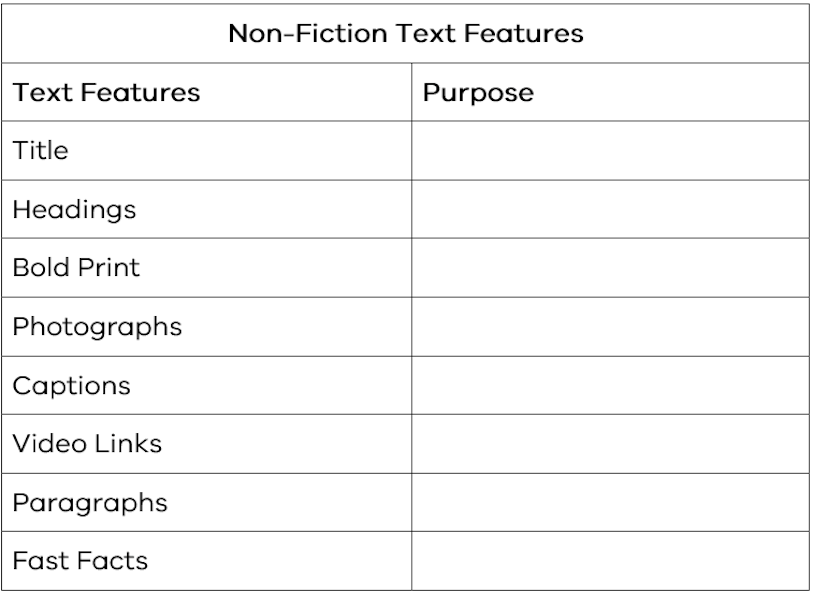Suggested Learning Intentions
- To examine the structures of information and explanation texts
- To understand the purpose of text structures
Sample Success Criteria
- I can identify specific text structures such as headings, subheadings, indexes and glossaries
- I can explain the purpose of specific text structures
- Pre-prepared T-chart to be developed as a class anchor chart, recording text structures and their purpose
- Information texts on animal adaptions that provide examples of text structures
- Text Features Plenary: docx PDF
Ask students to select the ‘odd one out’ from the following texts:
- information report, explanation report, recipe, biography, science fiction
Finding the odd one out can be used as a starter or plenary activity. Students are given a list of five or more items or concepts and they are challenged to find and justify their choice of the “odd one out”.
Facilitate discussion to cover the purpose and features of each text type. Note that science fiction could be considered the odd one out because it is a fictional text.
Remove science fiction from the list and ask the students to again suggest the odd one out.
Lead the discussion to identify the purpose of each text type: biography (telling about a person’s life), a recipe (an instructional text), and information and explanation reports to provide information or explain a factual event or natural phenomenon.
Establish prior knowledge by asking:
- What is the purpose of an information text?
- What text features are we likely to see in an information or explanation text?
- How do those features help the reader?
Record student responses on an anchor chart, such as the following:

You may wish to discuss the difference between text structures and language features. Refer to the Literacy Teaching Toolkit and the English Glossary for a summary of the major language or grammatical features of explanation texts.
Select an engaging non-fiction text to read with the students. While reading the text, highlight and discuss text structures and features.
- ABC Education has an online resource, Curious Kids, where experts answer questions. For example: How do penguins stay warm in Antarctica? The resource includes written and video information. Many other examples are available through this resource.
- Alternatively, you could use a hardcopy explanation text and explicitly highlight text structures and features.
Discuss the text type and purpose of the text. For example, explanation texts explain an event or phenomenon to give general information or to answer a specific question.
Explain that non-fiction texts such as reports and explanations, have particular structures and features that help the reader to locate and understand the information.
Lead a shared reading of a short text, scanning for structures and features.
Record the text features as you read on the prepared anchor chart. Invite student questions and discussion.
Guide students to select appropriate non-fiction texts to read independently or in collaborative pairs.
Provide sticky notes for students to identify and record text features.
Invite students to work in collaborative groups to discuss and record the possible purpose of each text feature and suggest how each feature helps the reader understand and navigate the text.
Enable students requiring further support by showing them this short video explaining non-fiction features.
Extend student understanding by encouraging them to compare the text features of a variety of text types, for example, digital, video and print.
Invite students to add their sticky notes to the class anchor chart.
Discuss the purpose of each text feature as it is added to the anchor chart and complete the ‘purpose’ section of the anchor chart.
As a possible exit activity, distribute one card from the Text Features Plenary to each student, with either a text feature or purpose clearly stated on the card. Students find their partner by matching feature to purpose.
Continue to develop the list of text features on the anchor chart throughout the sequence.
Kelley, M. & Clausen-Grace, N., n.d. Guiding Students through Expository Text with Text Feature Walks. [Online]
Available at: www.readingrockets.org/article/guiding-students-through-expository-text-text-feature-walks
[Accessed 15 March 2022].
The Bespectacled Librarian, 2015. Nonfiction Text Features. [Online]
Available at: www.youtube.com/watch?v=3mAl9QMJJTo
[Accessed 15 March 2022].
The Conversation, 2019. Curious Kids: How do penguins stay warm in Antarctica?, ABC Education. [Online]
Available at: https://theconversation.com/curious-kids-how-can-penguins-stay-warm-in-the-freezing-cold-waters-of-antarctica-116831
[Accessed 15 March 2022].
Other stages
1. Defining Physical and Behavioural Adaptations
EXPLORESuggested Learning Intentions
- To understand how adaptations help living things survive in different habitats
Sample Success Criteria
- I can explain what is meant by the term 'adaptation’
- I can explain how a particular adaptation helps a living thing survive
2. Posing and Researching Questions
EXPLORESuggested Learning Intentions
- To pose questions about the natural world
- To locate information to answer questions
Sample Success Criteria
- I can pose clarifying and probing questions
- I can gather information to answer my questions
4. Paragraphs: Finding the Main Idea and Supporting Details
EXPLORESuggested Learning Intentions
- To understand the features and purpose of paragraphs
Sample Success Criteria
- I can identify the topic sentence and supporting detail in a paragraph
- I can write a paragraph with a topic sentence and supporting detail
5. Using Vocabulary to Improve Meaning
EXPLORESuggested Learning Intentions
- To understand how vocabulary adds meaning to writing
Sample Success Criteria
- I can identify how vocabulary in texts adds to the meaning of the text
- I can use topic specific vocabulary in my writing
6. Researching and Creating Non-Fiction Texts
EXPLORESuggested Learning Intentions
- To plan, draft and publish a non-fiction text
Sample Success Criteria
- I can use non-fiction text structures, such as headings, sub-headings, paragraphs and images in my writing
- I can use topic specific vocabulary